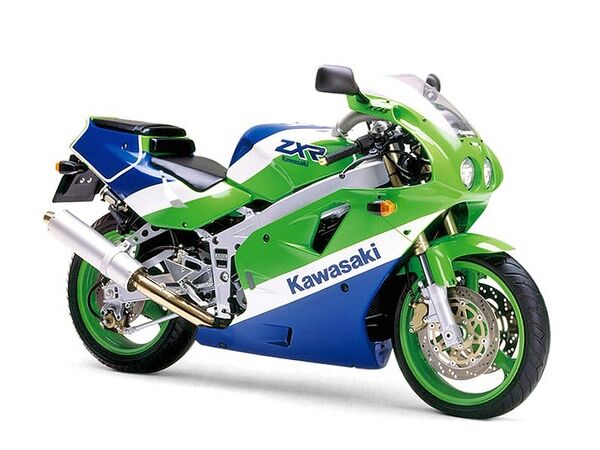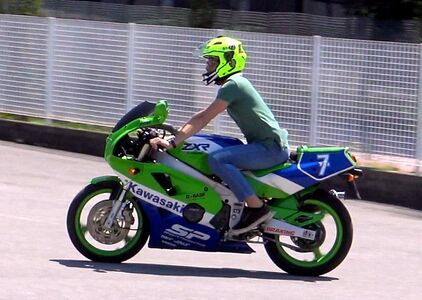Difference between revisions of "Kawasaki ZXR400"
m |
m |
||
| (7 intermediate revisions by the same user not shown) | |||
| Line 1: | Line 1: | ||
| − | {{DISPLAYTITLE:Kawasaki ZXR 400 (ZX400H | + | {{DISPLAYTITLE: Kawasaki ZXR 400 (ZX400H/L/J/M)}} |
| − | |||
{{#seo: | {{#seo: | ||
| − | |keywords= | + | |keywords={{PAGENAME}}, review, specs, owners manual, service manual, guide |
| + | |og:image=https://en.enduro.team/images/f/fa/Kawasaki-zxr400.jpg | ||
}} | }} | ||
__notoc__ | __notoc__ | ||
| − | + | [[file: Kawasaki-zxr400.jpg | 600px | center | Kawasaki ZXR400 (ZX400H) 1989-1990]] | |
| − | + | The sports motorcycle ''' Kawasaki ZXR 400 ''' appeared in 1989, replacing the model [[Kawasaki_GPX400 | Kawasaki GPX400R]], which by that time had "grown" into two models - Kawasaki ZXR400 and [[Kawasaki_ZZR400 | Kawasaki ZZ -R400]]. Specifically, the ZXR400 was modeled after the ZXR-4 racing model used in the TT-F3 series. | |
| − | + | {{Ads_top}} | |
| − | |||
| − | |||
| − | |||
| − | |||
| − | |||
| − | + | ''' Lineup: ''' | |
| + | * [[Kawasaki_ZXR250 | Kawasaki ZXR 250]] | ||
| + | * [[Kawasaki_ZXR400 | Kawasaki ZXR 400]] | ||
| + | * [[Kawasaki_ZXR750 | Kawasaki ZXR 750]] | ||
| − | + | ''' Main competitors: ''' | |
| − | * | + | * [[Suzuki_GSX-R400 | Suzuki GSX-R400]] |
| − | * | + | * [[Honda_CBR400RR | Honda CBR400]] |
| + | * [[Honda_VFR_ (RVF) _400 | Honda VFR400 (RVF400)]] | ||
| + | * [[Yamaha_FZR400RR | Yamaha FZR400RR]] | ||
| − | + | At the time of its release, the Kawasaki ZXR 400 featured many advanced technologies found only in racing models. First, the model received a rigid aluminum frame. Secondly, the sporty, fully adjustable suspension (inverted fork). Thirdly, the ram-air system, which increases the maximum power. Fourth, powerful 4-piston brakes. Fifth, Kawasaki's proprietary technologies: | |
| − | |||
| − | |||
| − | + | * '''K-CAS''' - air duct system for cylinder head cooling. | |
| + | * '''K-BATL''' - torque limiting system (excludes locking of the rear wheel on a sharp downshift). | ||
| + | * '''KIS-ARM''' - swingarm mechanism that increases the rigidity of the rear suspension and reduces its weight. | ||
| − | + | ''' Modifications: ''' | |
| + | * '''Kawasaki ZXR400''' (ZX400H, ZX400L) - regular version. | ||
| + | * '''Kawasaki ZXR400R''' (ZX400J, ZX400M) - "racing" version. Features a plug in the passenger seat, fully adjustable suspensions, different camshafts (taller cams) and flat throttle (FCR) carburetors (Keihin FVKD). | ||
| − | + | Another feature of the Kawasaki ZXR 400 is the fact that it was available not only in Japan, but also supplied to European countries. Export modifications produced up to 65 hp. power. Based on the Kawasaki ZXR 400 engine, the naked [[Kawasaki_Xanthus_400 | Kawasaki Xanthus 400]] was created. | |
| − | |||
| − | |||
| − | |||
| − | + | 1999 was the last year of production of the model, after which it was finally removed from the Kawasaki production line. Nevertheless, the Kawasaki ZXR400 has gained great popularity not only in Japan, but also in some countries around the world. The most powerful in its class and more racing-like prototypes, the ZXR400 stands out clearly from similar models from other Japanese manufacturers. | |
| − | |||
| − | |||
| − | |||
| − | |||
| − | == | + | == Photos == |
| − | + | <gallery mode="packed" heights=200px> | |
| − | + | File:Zxr400 aswee.jpg| | |
| − | + | File:Bikepics-1646327-full.jpg| | |
| − | + | File:2000-Kawasaki-ZXR400-503407.jpg| | |
| − | + | </gallery> | |
| − | + | {{Ads_feed}} | |
| − | + | {{Ads_post}} | |
| − | |||
| − | |||
| − | |||
| − | == | + | == Specifications == |
| − | + | Specifications Kawasaki ZXR 400: | |
| − | {| class="wikitable" | + | {| class = "wikitable" |
| − | ! scope="row"| | + | ! scope = "row" | Model |
| − | |Kawasaki ZXR400 | + | | Kawasaki ZXR400 |
|- | |- | ||
| − | ! scope="row"| | + | ! scope = "row" | Motorcycle type |
| − | | | + | | sports |
|- | |- | ||
| − | ! scope="row"| | + | ! scope = "row" | Release year |
| − | |1989-1999 | + | | 1989-1999 |
|- | |- | ||
| − | ! scope="row"| | + | ! scope = "row" | Frame |
| − | | | + | | aluminum diagonal |
|- | |- | ||
| − | ! scope="row"| | + | ! scope = "row" | Engine type |
| − | |4- | + | | 4-cylinder, 4-stroke, in-line |
|- | |- | ||
| − | ! scope="row"| | + | ! scope = "row" | Working volume |
| − | |398 | + | | 398 cm³ |
|- | |- | ||
| − | ! scope="row"| | + | ! scope = "row" | Bore / Stroke |
| − | |57 | + | | 57.0 x 39.0mm |
|- | |- | ||
| − | ! scope="row"| | + | ! scope = "row" | Compression ratio |
| − | |12.1:1 | + | | 12.1: 1 |
|- | |- | ||
| − | ! scope="row"| | + | ! scope = "row" | Cooling |
| − | | | + | | liquid |
|- | |- | ||
| − | ! scope="row"| | + | ! scope = "row" | Number of valves per cylinder |
| − | |DOHC, 4 | + | | DOHC, 4 valves per cylinder |
|- | |- | ||
| − | ! scope="row"| | + | ! scope = "row" | Fuel supply system |
| − | | | + | | Carburetor, 4x Keihin CVKD32 - ZX400H, ZX400L |
| − | + | Carburetor, 4x Keihin CVKD30 - ZX400L3-L9 (Japanese versions) | |
| − | + | Carburetor, 4x Keihin FVKD32 (flat throttle) - ZX400J, ZX400M | |
|- | |- | ||
| − | ! scope="row"| | + | ! scope = "row" | Ignition type |
| − | | | + | | transistor |
|- | |- | ||
| − | ! scope="row"| | + | ! scope = "row" | Maximum power |
| − | |62 | + | | 62.0 h.p. (45.6 kW) @ 12,500 rpm - ZX400H, ZX400J with inertial supercharging |
| − | 59 | + | 59.0 h.p. (43.0 kW) at 12000 rpm - without inertial boost |
| − | 65 | + | 65.0 h.p. (47.8 kW) @ 13000 rpm - ZX400L, ZX400M with inertial supercharging |
| − | 53 | + | 53.0 h.p. (39.0 kW) @ 12000 rpm - ZX400L3-L9 (Japanese versions) |
|- | |- | ||
| − | ! scope="row"| | + | ! scope = "row" | Maximum torque |
| − | |39 | + | | 39.2 Nm (4.0 kg * m) at 10,000 rpm - ZX400H, ZX400J |
| − | 36 | + | 36.3 Nm (3.7 kg * m) @ 12000 rpm - ZX400L, ZX400M |
|- | |- | ||
| − | ! scope="row"| | + | ! scope = "row" | Gearbox |
| − | |6- | + | | 6-speed |
|- | |- | ||
| − | ! scope="row"| | + | ! scope = "row" | Drive type |
| − | | | + | | chain |
|- | |- | ||
| − | ! scope="row"| | + | ! scope = "row" | Front tire size |
| − | |120/60 R17 55H | + | | 120/60 R17 55H |
|- | |- | ||
| − | ! scope="row"| | + | ! scope = "row" | Rear tire size |
| − | |160/60 R17 69H | + | | 160/60 R17 69H |
|- | |- | ||
| − | ! scope="row"| | + | ! scope = "row" | Front brakes |
| − | |2 | + | | 2 discs, 300mm, 4-piston calipers - ZX400H, ZX400J |
| − | 2 | + | 2 discs, 310mm, 4-piston calipers - ZX400L, ZX400M |
|- | |- | ||
| − | ! scope="row"| | + | ! scope = "row" | Rear brakes |
| − | |1 | + | | 1 disc, 220 mm, 2-piston caliper |
|- | |- | ||
| − | ! scope="row"| | + | ! scope = "row" | Front suspension |
| − | | | + | | Inverted Fork (Adjustable) - 120mm Travel - ZXR400 |
| − | + | Inverted Fork (All Adjustments) - 120mm Travel - ZXR400R | |
|- | |- | ||
| − | ! scope="row"| | + | ! scope = "row "| Rear suspension |
| − | | | + | | linkage Uni-Trak with monoshock (adjustable), stroke - 140 mm - ZX400H, ZX400J |
| − | + | linkage Uni-Trak with monoshock (adjustable), stroke - 120 mm - ZX400L, ZX400M | |
|- | |- | ||
| − | ! scope="row"| | + | ! scope = "row" | Motorcycle length |
| − | |2035 | + | | 2035 mm - ZX400H |
| − | 2025 | + | 2025 mm - ZX400J |
| − | 1995 | + | 1995 mm - ZX400L, ZX400M |
|- | |- | ||
| − | ! scope="row"| | + | ! scope = "row" | Motorcycle width |
| − | |705 | + | | 705 mm - ZX400H, ZX400J |
| − | 710 | + | 710 mm - ZX400L, ZX400M |
|- | |- | ||
| − | ! scope="row"| | + | ! scope = "row" | Motorcycle height |
| − | |1125 | + | | 1125 mm - ZX400H, ZX400J |
| − | 1080 | + | 1080 mm - ZX400L, ZX400M |
|- | |- | ||
| − | ! scope="row"| | + | ! scope = "row" | Wheelbase |
| − | |1395 | + | | 1395 mm - ZX400H, ZX400J |
| − | 1385 | + | 1385 mm - ZX400L, ZX400M |
|- | |- | ||
| − | ! scope="row"| | + | ! scope = "row" | Saddle height |
| − | |765 | + | | 765 mm - ZX400H, ZX400J |
| − | 760 | + | 760 mm - ZX400L, ZX400M |
|- | |- | ||
| − | ! scope="row"| | + | ! scope = "row" | Minimum ground clearance |
| − | |120 | + | | 120 mm - ZX400H, ZX400J |
| − | 115 | + | 115 mm - ZX400L, ZX400M |
|- | |- | ||
| − | ! scope="row"| | + | ! scope = "row" | Acceleration to 100 km / h |
| − | |4 | + | | 4.3 sec. |
|- | |- | ||
| − | ! scope="row"| | + | ! scope = "row" | Maximum speed |
| − | |180 | + | | 180 km / h (Japanese versions, with limiter) |
|- | |- | ||
| − | ! scope="row"| | + | ! scope = "row" | Fuel tank capacity |
| − | |16 | + | | 16.0 l |
|- | |- | ||
| − | ! scope="row"| | + | ! scope = "row" | Motorcycle weight (dry) |
| − | |162 | + | | 162 kg - ZX400H |
| − | 160 | + | 160 kg - ZX400J, ZX400L |
| − | 159 | + | 159 kg - ZX400M |
|- | |- | ||
|} | |} | ||
| − | == | + | == Documentation == |
| − | + | [[Category:Motorcycles]] | |
| − | + | * [[Kawasaki_ZXR400:_manuals|Kawasaki ZXR 400]] | |
| − | |||
| − | |||
| − | |||
| − | |||
| − | |||
| − | == | + | == == |
| − | + | {{Ads_recomended}} | |
Latest revision as of 14:53, 20 July 2023
The sports motorcycle Kawasaki ZXR 400 appeared in 1989, replacing the model Kawasaki GPX400R, which by that time had "grown" into two models - Kawasaki ZXR400 and Kawasaki ZZ -R400. Specifically, the ZXR400 was modeled after the ZXR-4 racing model used in the TT-F3 series.
Lineup:
Main competitors:
At the time of its release, the Kawasaki ZXR 400 featured many advanced technologies found only in racing models. First, the model received a rigid aluminum frame. Secondly, the sporty, fully adjustable suspension (inverted fork). Thirdly, the ram-air system, which increases the maximum power. Fourth, powerful 4-piston brakes. Fifth, Kawasaki's proprietary technologies:
- K-CAS - air duct system for cylinder head cooling.
- K-BATL - torque limiting system (excludes locking of the rear wheel on a sharp downshift).
- KIS-ARM - swingarm mechanism that increases the rigidity of the rear suspension and reduces its weight.
Modifications:
- Kawasaki ZXR400 (ZX400H, ZX400L) - regular version.
- Kawasaki ZXR400R (ZX400J, ZX400M) - "racing" version. Features a plug in the passenger seat, fully adjustable suspensions, different camshafts (taller cams) and flat throttle (FCR) carburetors (Keihin FVKD).
Another feature of the Kawasaki ZXR 400 is the fact that it was available not only in Japan, but also supplied to European countries. Export modifications produced up to 65 hp. power. Based on the Kawasaki ZXR 400 engine, the naked Kawasaki Xanthus 400 was created.
1999 was the last year of production of the model, after which it was finally removed from the Kawasaki production line. Nevertheless, the Kawasaki ZXR400 has gained great popularity not only in Japan, but also in some countries around the world. The most powerful in its class and more racing-like prototypes, the ZXR400 stands out clearly from similar models from other Japanese manufacturers.
Photos
Specifications
Specifications Kawasaki ZXR 400:
| Model | Kawasaki ZXR400 |
|---|---|
| Motorcycle type | sports |
| Release year | 1989-1999 |
| Frame | aluminum diagonal |
| Engine type | 4-cylinder, 4-stroke, in-line |
| Working volume | 398 cm³ |
| Bore / Stroke | 57.0 x 39.0mm |
| Compression ratio | 12.1: 1 |
| Cooling | liquid |
| Number of valves per cylinder | DOHC, 4 valves per cylinder |
| Fuel supply system | Carburetor, 4x Keihin CVKD32 - ZX400H, ZX400L
Carburetor, 4x Keihin CVKD30 - ZX400L3-L9 (Japanese versions) Carburetor, 4x Keihin FVKD32 (flat throttle) - ZX400J, ZX400M |
| Ignition type | transistor |
| Maximum power | 62.0 h.p. (45.6 kW) @ 12,500 rpm - ZX400H, ZX400J with inertial supercharging
59.0 h.p. (43.0 kW) at 12000 rpm - without inertial boost 65.0 h.p. (47.8 kW) @ 13000 rpm - ZX400L, ZX400M with inertial supercharging 53.0 h.p. (39.0 kW) @ 12000 rpm - ZX400L3-L9 (Japanese versions) |
| Maximum torque | 39.2 Nm (4.0 kg * m) at 10,000 rpm - ZX400H, ZX400J
36.3 Nm (3.7 kg * m) @ 12000 rpm - ZX400L, ZX400M |
| Gearbox | 6-speed |
| Drive type | chain |
| Front tire size | 120/60 R17 55H |
| Rear tire size | 160/60 R17 69H |
| Front brakes | 2 discs, 300mm, 4-piston calipers - ZX400H, ZX400J
2 discs, 310mm, 4-piston calipers - ZX400L, ZX400M |
| Rear brakes | 1 disc, 220 mm, 2-piston caliper |
| Front suspension | Inverted Fork (Adjustable) - 120mm Travel - ZXR400
Inverted Fork (All Adjustments) - 120mm Travel - ZXR400R |
| Rear suspension | linkage Uni-Trak with monoshock (adjustable), stroke - 140 mm - ZX400H, ZX400J
linkage Uni-Trak with monoshock (adjustable), stroke - 120 mm - ZX400L, ZX400M |
| Motorcycle length | 2035 mm - ZX400H
2025 mm - ZX400J 1995 mm - ZX400L, ZX400M |
| Motorcycle width | 705 mm - ZX400H, ZX400J
710 mm - ZX400L, ZX400M |
| Motorcycle height | 1125 mm - ZX400H, ZX400J
1080 mm - ZX400L, ZX400M |
| Wheelbase | 1395 mm - ZX400H, ZX400J
1385 mm - ZX400L, ZX400M |
| Saddle height | 765 mm - ZX400H, ZX400J
760 mm - ZX400L, ZX400M |
| Minimum ground clearance | 120 mm - ZX400H, ZX400J
115 mm - ZX400L, ZX400M |
| Acceleration to 100 km / h | 4.3 sec. |
| Maximum speed | 180 km / h (Japanese versions, with limiter) |
| Fuel tank capacity | 16.0 l |
| Motorcycle weight (dry) | 162 kg - ZX400H
160 kg - ZX400J, ZX400L 159 kg - ZX400M |
Documentation



